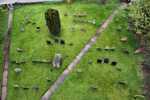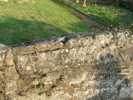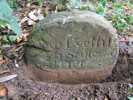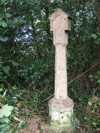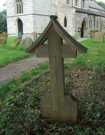For this church:    |
Cromwell St GilesChurchyard
The churchyard surrounds the church on all sides, and is approximately 2.5 roods in area (0.625acres or 0.25 hectares). To the west and on part of the adjacent south side, it is bounded by a stone wall, partly topped with hogback stones, possibly of medieval origin, though the date of the wall’s construction is probably relatively modern. It is maintained by the parish. To the north there is a hedge. The east side and part of the south sides are also hedged; both of these hedges are owned by adjacent properties. A number of mature trees grow in or close to the boundary on all sides, including a lime, yew and two horse chestnuts. There are two 19th century wrought-iron gates at either end of the wall on the west, with paths converging just before the main south doorway. A small plot to the north of the nave is reserved for burial of cremated remains and the churchyard is still open. Historically, it is known that bodies were being buried in the church from at least the later 15th century. In 1585 the churchwardens were cited to appear at the next Archdeaconry court at Newark on 8 September because the churchyard was then ‘out of repair’. The registers record burials in the churchyard from 1652 onwards. The earliest surviving gravestone dates to shortly after 1700. Presently some 190 gravestones survive. Most of the older ones are either sandstone or Swithland slate, but limestone, granite and modern composites have been used for more recent ones. In 1731 orders were given to repair stones, presumably forming a wall, at the east end either with palings or a wall. The upkeep of the hedges and trees was a frequent matter of concern to the wardens and Archdeacons in the 18th and 19th centuries. One set of gates was erected in 1859. In 1872, an old fence was taken down, and new iron railings erected for part of the boundary. When the church had a sexton, maintenance of the churchyard was part of his duties. While a fair proportion of the yard is currently mown regularly, occasional working parties tackle the more vigorous undergrowth and bramble which have invaded some parts.
One of the monuments most threatened is the fragmentary octagonal medieval village cross of around 1300 which was placed in the churchyard in 1874. It was restored by the rector, Henry Fiennes-Clinton, as a memorial to his wife in 1898, and he himself was buried nearby in 1911. Towards the south-east corner are two box tombs, one for the curate, Robert Gunthorp (d1745, aged 37); and the other for an unfortunate London merchant, George Welbank who died in Cromwell in 1751, aged 35, having fallen from his horse. Another very fine box tomb survives on the west side, erected to the memory of a wealthy local farmer, James Bradley (d1829, aged 90) and his wife, Anne (d1811, aged 70). On the south side near a fine old yew tree, is a tombstone carved in 1927 with a Pieta by J Cribb, pupil and associate of Eric Gill, with the oldest gravestone, that of John Sturtevant (d170x) close by; the next oldest gravestone is that of John Camamile who died in 1713, aged 62. On the north side there is the grave of Guy Hemingway (d1986, aged 86).
Another rector, William Dolman (d1958), is buried in the churchyard. His grave is marked by a wooden cross, as is that of the Rev A L Thomas (d1964, aged 88) who officiated at Cromwell during his retirement. |


